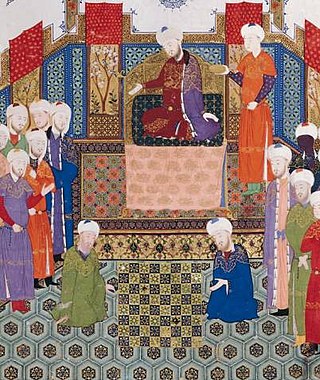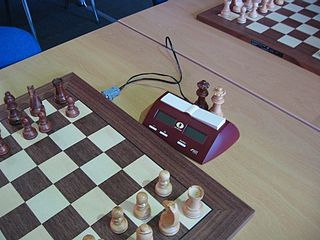
The queen is the most powerful piece in the game of chess. It can move any number of squares vertically, horizontally or diagonally, combining the powers of the rook and bishop. Each player starts the game with one queen, placed in the middle of the first rank next to the king. Because the queen is the strongest piece, a pawn is promoted to a queen in the vast majority of cases.

A chess piece, or chessman, is a game piece that is placed on a chessboard to play the game of chess. It can be either white or black, and it can be one of six types: king, queen, rook, bishop, knight, or pawn.

The knight is a piece in the game of chess, represented by a horse's head and neck. It moves two squares vertically and one square horizontally, or two squares horizontally and one square vertically, jumping over other pieces. Each player starts the game with two knights on the b- and g-files, each located between a rook and a bishop.

Shatranj is an old form of chess, as played in the Sasanian Empire. Its origins are in the Indian game of chaturaṅga. Modern chess gradually developed from this game, as it was introduced to Europe by contacts in Muslim Al-Andalus and in Sicily in the 10th century.
A fairy chess piece, variant chess piece, unorthodox chess piece, or heterodox chess piece is a chess piece not used in conventional chess but incorporated into certain chess variants and some chess problems. Compared to conventional pieces, fairy pieces vary mostly in the way they move, but they may also follow special rules for capturing, promotions, etc. Because of the distributed and uncoordinated nature of unorthodox chess development, the same piece can have different names, and different pieces can have the same name in various contexts. Most are symbolised as inverted or rotated icons of the standard pieces in diagrams, and the meanings of these "wildcards" must be defined in each context separately. Pieces invented for use in chess variants rather than problems sometimes instead have special icons designed for them, but with some exceptions, many of these are not used beyond the individual games for which they were invented.
Tamerlane chess is a medieval chess variant. Like modern chess, it is derived from shatranj. It was developed in Central Asia during the reign of Emperor Timur, and its invention is also attributed to him. Because Tamerlane chess is a larger variant of chaturanga, it is also called Shatranj Al-Kabir, as opposed to Shatranj as-saghir. Although the game is similar to modern chess, it is distinctive in that there are varieties of pawn, each of which promotes in its own way.

The empress is a fairy chess piece that can move like a rook or a knight. It cannot jump over other pieces when moving as a rook but may do so when moving as a knight. The piece has acquired many names and is frequently called a chancellor or a marshal.

In chess, promotion is the replacement of a pawn with a new piece when the pawn is moved to its last rank. The player replaces the pawn immediately with a queen, rook, bishop, or knight of the same color. The new piece does not have to be a previously captured piece. Promotion is mandatory when moving to the last rank; the pawn cannot remain as a pawn.
Tsume shogi or tsume (詰め) is the Japanese term for a shogi miniature problem in which the goal is to checkmate the opponent's king. Tsume problems usually present a situation that might occur in a shogi game, and the solver must find out how to achieve checkmate. It is similar to a mate-in-n chess problem.
A pawnless chess endgame is a chess endgame in which only a few pieces remain, and no pawns. The basic checkmates are types of pawnless endgames. Endgames without pawns do not occur very often in practice except for the basic checkmates of king and queen versus king, king and rook versus king, and queen versus rook. Other cases that occur occasionally are (1) a rook and minor piece versus a rook and (2) a rook versus a minor piece, especially if the minor piece is a bishop.
Shogi, like western chess, can be divided into the opening, middle game and endgame, each requiring a different strategy. The opening consists of arranging one's defenses and positioning for attack, the middle game consists of attempting to break through the opposing defenses while maintaining one's own, and the endgame starts when one side's defenses have been compromised.
The nightrider, alternatively spelled knightrider and also known as the knightmare or unicorn, is a fairy chess piece that can move any number of steps as a knight in the same direction. The nightrider is often represented by an altered version of the knight's icon. In this article, the nightrider is represented by an inverted knight and notated as N; the knight is abbreviated as S for the German name Springer.

The following outline is provided as an overview of and topical guide to chess:

The amazon, also known as the queen+knight compound or the dragon, is a fairy chess piece that can move like a queen or a knight. It may thus be considered the sum of all orthodox chess pieces other than the king and the pawn. The amazon can force checkmate on an enemy king without the help of any other friendly piece.
The ferz or fers is a fairy chess piece that may move one square diagonally. It was used in orthodox chess and in Shatranj form of chess before being replaced by the queen.
The dabbaba, also known as the dabaaba or dabbabah, is a fairy chess piece that jumps two squares orthogonally, leaping over any intermediate piece. In algebraic notation, it is given the symbol D.

The alfil, alpil, or elephant is a fairy chess piece that can jump two squares diagonally. It first appeared in shatranj. It is used in many historical and regional chess variants. It was used in standard chess before being replaced by the bishop in the 15th and 16th centuries.
The camel or long knight is a fairy chess piece with an elongated knight move. It can jump three squares horizontally and one square vertically or three squares vertically and one square horizontally, regardless of intervening pieces. Therefore, it is a (1,3)-leaper.

The zebra is a fairy chess piece that moves like a stretched knight. It jumps three squares horizontally and two squares vertically or three squares vertically and two squares horizontally, regardless of intervening pieces; thus, it is a (2,3)-leaper. A lame zebra, which moves one step orthogonally and then two steps diagonally outwards and can be blocked by intervening pieces, appears as the elephant in janggi.

The mann or man is a fairy chess piece that may move to any adjoining square. It is similar to the king, but it is not a royal piece, and it cannot castle. The mann is used in many chess variants. In this article's diagrams, the mann is represented by an inverted king.











